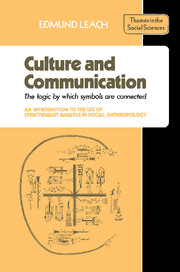 Culture and Communication
Culture and Communication Book contents
- Frontmatter
- Contents
- Culture and communication: the logic by which symbols are connected
- Introduction
- 1 Empiricists and rationalists: economic transactions and acts of communication
- 2 Problems of terminology
- 3 Objects, sense-images, concepts
- 4 Signals and indices
- 5 Transformations
- 6 Theories of magic and sorcery
- 7 The symbolic ordering of a man-made world: boundaries of social space and time
- 8 The material representation of abstract ideas: ritual condensation
- 9 Orchestral performance as a metaphor for ritual sequence
- 10 The physiological basis of sign/symbol sets
- 11 Mapping: time and space as reciprocal representations
- 12 Rank order and orientation
- 13 Examples of binary coding
- 14 Mating prescriptions and proscriptions
- 15 Logic and mytho-logic
- 16 Basic cosmology
- 17 Rites of transition (rites de passage)
- 18 The logic of sacrifice
- 19 Conclusion
- Bibliography
- Index
- Frontmatter
- Contents
- Culture and communication: the logic by which symbols are connected
- Introduction
- 1 Empiricists and rationalists: economic transactions and acts of communication
- 2 Problems of terminology
- 3 Objects, sense-images, concepts
- 4 Signals and indices
- 5 Transformations
- 6 Theories of magic and sorcery
- 7 The symbolic ordering of a man-made world: boundaries of social space and time
- 8 The material representation of abstract ideas: ritual condensation
- 9 Orchestral performance as a metaphor for ritual sequence
- 10 The physiological basis of sign/symbol sets
- 11 Mapping: time and space as reciprocal representations
- 12 Rank order and orientation
- 13 Examples of binary coding
- 14 Mating prescriptions and proscriptions
- 15 Logic and mytho-logic
- 16 Basic cosmology
- 17 Rites of transition (rites de passage)
- 18 The logic of sacrifice
- 19 Conclusion
- Bibliography
- Index
Summary
Now that we have come to the end I suggest that you go back to the beginning and re-read my Introduction and then decide how far I have fulfilled my promises.
The purpose of the long discussion of sacrifice in Section 18 was to illustrate my original assertions that ‘detail is the essence of the matter’, ‘every detail of custom must be seen as part of a complex’, ‘details, considered in isolation, are as meaningless as isolated letters of the alphabet’. But let us consider this analogy with letters of the alphabet more closely. What is the process by which we make letters convey information? We first select twenty-six marks from an infinity of possible marks and declare that these twenty-six marks constitute a set. Then we make an inventory of the sounds of our spoken language, cutting up the intonation continuum in a distinctly arbitrary way. We then allocate the arbitrarily distinguished sounds to the arbitrarily distinguished letter marks, and tidy things up by improvising a number of special combinations for sounds which will not fit. Then finally, by stringing the letters together in sequences, we produce a kind of model of natural speech or at any rate of an idealised version of natural speech.
If you think carefully about the evidence provided by my sacrifice example you will see that the analogy goes quite a long way. The elements of the ritual (‘the letters of the alphabet’) do not mean anything in themselves; they come to have meaning by virtue of contrast with other elements.
- Type
- Chapter
- Information
- Culture and CommunicationThe Logic by which Symbols Are Connected. An Introduction to the Use of Structuralist Analysis in Social Anthropology, pp. 95 - 98Publisher: Cambridge University PressPrint publication year: 1976


